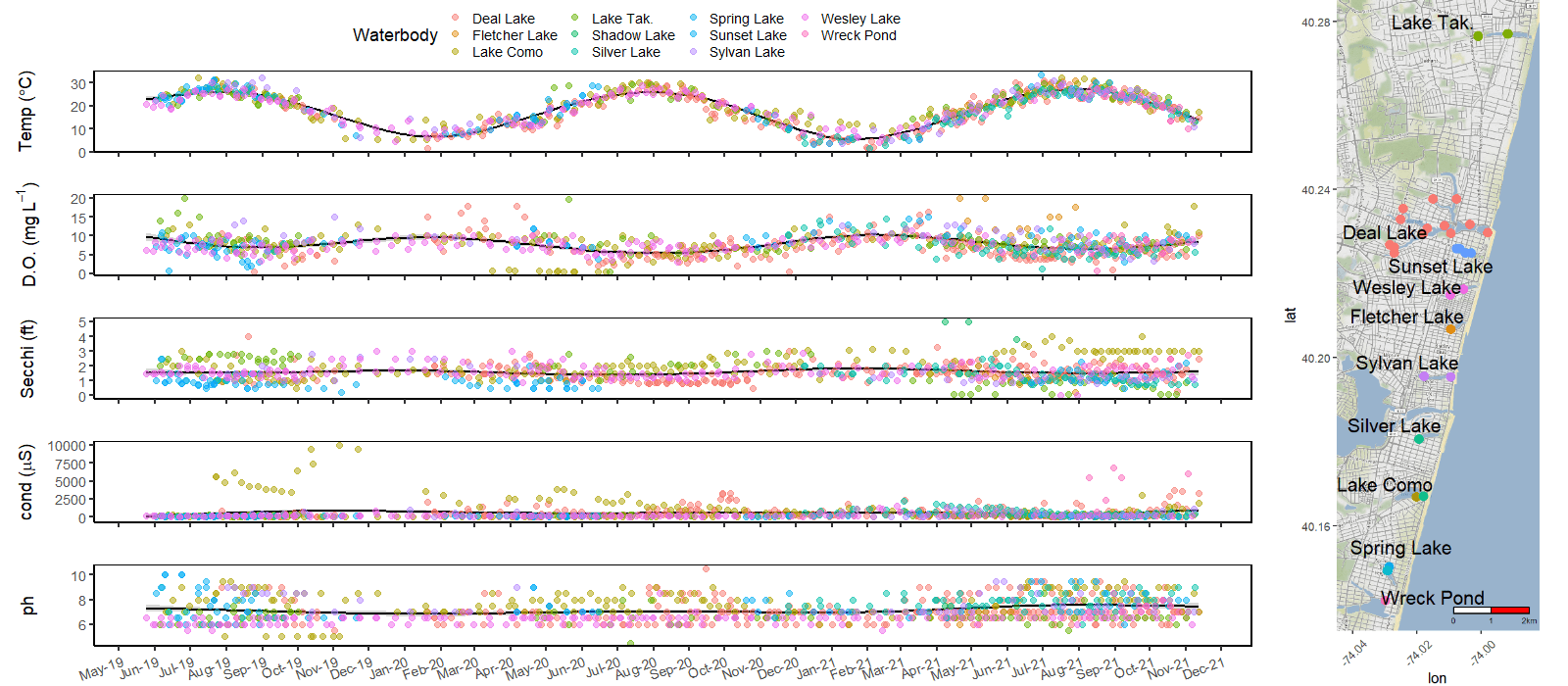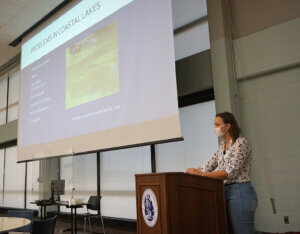
Residents of Monmouth County coastal communities can now view data on the health and characteristics of their lakes and compare them to others with a new web app created by the Coastal Lakes Observing Network (CLONet). The launch of the CLONet Data Explorer was one of a number of new initiatives and changes to citizen science activities announced for the year ahead at the CLONet Fall Meeting, held Nov. 16 at Monmouth University.
Through CLONet, university scientists and students train and equip community members to sample Monmouth County’s beach-adjacent lakes for properties such as temperature, salinity, clarity and dissolved oxygen levels, then file their readings into an online database. Since the summer of 2019, the citizen scientists and university researchers have been sampling Deal Lake, Fletcher Lake, Lake Como, Lake Takanassee, Silver Lake, Spring Lake, Sunset Lake, Sylvan Lake, Wesley Lake and Wreck Pond. A team was also recently formed to sample Shadow Lake in Middletown.
The web app allows users to view readings for all of the sampled lakes together on one graph; data for any single lake of interest vs. the average of all of the lakes; and averages for each lake by category. Users can toggle through date ranges to study data from specific windows of time, with new data from the sampling teams added to the system every two weeks.

As of the meeting, the citizen scientists had filed 897 sampling reports since the summer of 2019, with the data augmented by hundreds of additional samples taken regularly by Monmouth faculty and students. The Urban Coast Institute (UCI) received a $150,000 grant from the Jules L. Plangere, Jr. Family Foundation in July that will allow sampling to continue through at least the summer of 2023.
The funding also covered the purchase of 11 phycocyanin meters, which will be provided to each of the lake teams to enable them to measure harmful algal blooms (HAB) with greater accuracy. The handheld meters shine fluorescent light in the water to gauge the concentrations of “blue-green algae” – actually a potentially toxic bacteria called cyanobacteria — most commonly associated with HABs. Although the New Jersey Department of Environmental Protection (NJDEP) measures cell counts and toxin levels in the waters as its main indicators of HABs, the data from the two methods tend to tell very similar stories, according to Monmouth University Endowed Associate Professor of Marine Science and CLONet Coordinator Jason Adolf.
“An army of citizen scientists with phycocyanin probes can make a real contribution to the state’s efforts to manage and monitor harmful algal blooms, not just in coastal lakes but statewide,” Adolf said. “I’m excited to get our group started on it.”
Findings from 2021
Adolf and UCI Community Science Coordinator Erin Conlon provided a snapshot of the findings from this year’s data to attendees.
- Particularly compared to 2019, 2021 was a “good year” for the lakes in terms of the low number of HAB events.
- There was a high correspondence between the readings taken by the community volunteers and university, demonstrating the high quality of data being gathered by citizen scientists. The Monmouth staff members and students regularly sample each CLONet lake as a quality control measure and to bolster the volume of data project-wide.
- Surges in salt levels were recorded in February and March, as snows melted and carried road salts into the drains.
- Adolf and Conlon said the data gathered for pH testing was so varied from lake to lake that it didn’t seem to reveal any discernable patterns. Citizen teams will no longer record pH levels in 2022.
The data continued to show that the combination of high temperatures and nutrients made conditions ripe for spikes in HABs. While rainfall is suspected to be an important source of nutrients to these lakes, citizen data shows that not all of the lakes reacted the same after storm events. Citizen conductivity data suggested some lakes respond very quickly (within days) and other more slowly (1-2 weeks) to rainfall.
“This is a great illustration of how citizen data can be used to reveal important differences among coastal lakes, and how we need to think about individual lakes when we think about solutions,” Adolf said.
If you’re interested in volunteering to sample your community lake or would like more information about CLONet, email econlon@monmouth.edu.
